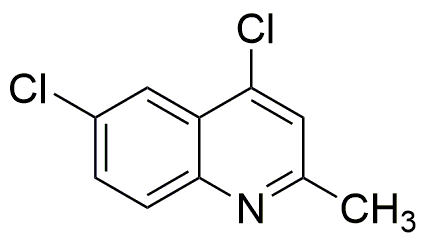4,6-Dichloro-2-methylquinoline is widely utilized in research focused on:
- Pharmaceutical Development: This compound is a key intermediate in the synthesis of various pharmaceuticals, particularly in developing antimicrobial agents. Its unique structure allows for modifications that enhance efficacy against resistant bacterial strains.
- Agricultural Chemicals: It serves as a precursor in the formulation of agrochemicals, including herbicides and fungicides, helping to improve crop yield and protect against pests while minimizing environmental impact.
- Material Science: The compound is used in creating specialized coatings and polymers, providing enhanced durability and resistance to environmental degradation, which is crucial for applications in construction and automotive industries.
- Research in Biochemistry: It is employed in various biochemical assays and studies, particularly in exploring enzyme inhibition mechanisms, which can lead to breakthroughs in understanding metabolic pathways.
- Analytical Chemistry: The compound is utilized as a standard in chromatographic techniques, aiding in the accurate analysis of complex mixtures in both industrial and research settings.
Información general
Propiedades
Seguridad y normativas
Aplicaciones
4,6-Dichloro-2-methylquinoline is widely utilized in research focused on:
- Pharmaceutical Development: This compound is a key intermediate in the synthesis of various pharmaceuticals, particularly in developing antimicrobial agents. Its unique structure allows for modifications that enhance efficacy against resistant bacterial strains.
- Agricultural Chemicals: It serves as a precursor in the formulation of agrochemicals, including herbicides and fungicides, helping to improve crop yield and protect against pests while minimizing environmental impact.
- Material Science: The compound is used in creating specialized coatings and polymers, providing enhanced durability and resistance to environmental degradation, which is crucial for applications in construction and automotive industries.
- Research in Biochemistry: It is employed in various biochemical assays and studies, particularly in exploring enzyme inhibition mechanisms, which can lead to breakthroughs in understanding metabolic pathways.
- Analytical Chemistry: The compound is utilized as a standard in chromatographic techniques, aiding in the accurate analysis of complex mixtures in both industrial and research settings.
Documentos
Hojas de datos de seguridad (HDS)
La SDS proporciona información de seguridad completa sobre la manipulación, el almacenamiento y la eliminación del producto.
Especificación del producto (PS)
La PS proporciona un desglose completo de las propiedades del producto, incluida la composición química, el estado físico, la pureza y los requisitos de almacenamiento. También detalla los rangos de calidad aceptables y las aplicaciones previstas del producto.
Certificados de análisis (COA)
Busque certificados de análisis (COA) ingresando el número de lote del producto. Los números de lote y de partida se pueden encontrar en la etiqueta de un producto después de las palabras "Lote" o "Lote".
Número de catálogo
Número de lote/lote
Certificados de origen (COO)
Este certificado de origen confirma el país en el que se fabricó el producto y también detalla los materiales y componentes utilizados en él y si se deriva de fuentes naturales, sintéticas u otras fuentes específicas. Este certificado puede ser necesario para cumplir con las normativas aduaneras, comerciales y regulatorias.
Número de catálogo
Número de lote/lote
Hojas de datos de seguridad (HDS)
La SDS proporciona información de seguridad completa sobre la manipulación, el almacenamiento y la eliminación del producto.
DownloadEspecificación del producto (PS)
La PS proporciona un desglose completo de las propiedades del producto, incluida la composición química, el estado físico, la pureza y los requisitos de almacenamiento. También detalla los rangos de calidad aceptables y las aplicaciones previstas del producto.
DownloadCertificados de análisis (COA)
Busque certificados de análisis (COA) ingresando el número de lote del producto. Los números de lote y de partida se pueden encontrar en la etiqueta de un producto después de las palabras "Lote" o "Lote".
Número de catálogo
Número de lote/lote
Certificados de origen (COO)
Este certificado de origen confirma el país en el que se fabricó el producto y también detalla los materiales y componentes utilizados en él y si se deriva de fuentes naturales, sintéticas u otras fuentes específicas. Este certificado puede ser necesario para cumplir con las normativas aduaneras, comerciales y regulatorias.


